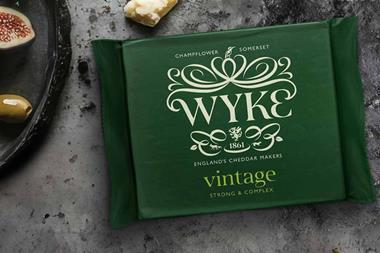Forget department stores. These days supermarkets are just as likely to be styling the nation. Fashionistas regularly mix their designer wear with "fashion finds" from the aisles of the big four. And we're not just talking fashion basics.
But as Tesco takes its offer up a notch with a more upmarket range and the launch of a transactional online site, can it close the gap with Asda's George, the current leader, and bite an even greater chunk out of the high street market?
George has set the pace in modern supermarket fashion and really picked up speed after Wal-Mart bought Asda in 1999, smashing through the £1bn barrier in 2003.
It's still riding high. Despite Sainsbury's claim to be "the fastest-growing clothing retailer in the country" at its half-year results, Tu still generates only £250m of sales, not even a third of Tesco's clothing receipts and not a sixth of George's.
But Tesco is catching up fast. This autumn it said it had £1bn sales in its sights. This surprisingly modest public ambition by Tesco's standards prompted one Asda director to remark: "We like to see Tesco aspiring to be number two." But Tesco has privately told City analysts its real aspiration is to hit £2bn in sales over the next four to five years - and it may well be aided by a slowdown in George's growth.
Space, or the lack of it, is an essential element to the success of any supermarket clothing offer and, put simply, Asda doesn't have as much as Tesco. Sainsbury's is in an even worse predicament thanks to its relatively small stores. Limited space results in the double-height fixtures that dominate this sector - not to mention the characteristically poor merchandising, though George has done the most to try and improve the look of its departments over the years.
Another significant factor is pricing. Despite their value sector credentials, none of the supermarkets is as cheap as Matalan or Primark, according to research from retail consultancy Retailmap.
"From the supermarkets' perspective, it is a balancing act between devoting sufficient options and space in-store to communicate low prices and value for money in order to drive footfall, yet at the same time to persuade shoppers, once in-store, to trade up to higher-priced (and higher-margin) merchandise," says Retailmap director Richard Fitzpatrick. "It is, after all, a lot more cost-effective to sell one £20 item of knitwear rather than 10 £2 T-shirts."
Hence the move upmarket. Since the arrival of Terry Green as head of clothing at Tesco, parts of the Florence & Fred range have turned into the F&F Collection. George, too, is becoming classier with its on-trend George Collection, better fabrics and more complicated constructions.
Of course, Sainsbury's went premium first, with Tu. But any first-mover advantage is not really relevant because of the limited scale of its stores and offer. "We are anything up to 15% under-ranged even in our biggest stores," says Richard Jones, its head of clothing. "We haven't done much footwear and only introduced men's tailoring this season. We can do more on women's petites and plus sizes, and sportswear."
That said, neither Asda nor Tesco are taking their eye off the value ball. And appealing to the style-savvy teen is high on the agenda. Angela Spindler, who has just celebrated her first anniversary as global MD for George, has been particularly pleased with its G21 range of funky fashion aimed at females 21 and younger. The styles have been extended down to sizes 4 and 6, not because George customers are particularly skeletal but to fit teenage girls who want to wear adult ranges, not dedicated teen ones. The lessons learned in women's and girls' wear are to be used to develop new fashion ranges from men and teenage boys.
Responding to criticism about "value" ranges, Spindler acknowledges that supermarket basics are, well, basic. "Up to 60% of the cost of a garment is in the fabric, so I would agree you do get what you pay for. Our ambition is to style our customers for less, so George covers all Asda customers with its Good-Better-Best policy. Not everything we do is meant just to be disposable fashion. Our simple aim is to have the best value/quality ratio and so be the best value at every price point we offer."
Spindler is also frank about the challenge in getting clothing right. "Anyone can sell basic socks and pants. The Aldis and the Lidls can do that, but people underestimate how hard it is to develop a truly credible fashion business," she says. "To make your offer into a destination shop with wide appeal requires a huge investment on virtually every level - space, people, time - and would necessitate a newcomer buying in clothing expertise because it's completely different from food."
Sainsbury's is determined to make it work by establishing a reputation for quality from the outset, says Jones. "We know the whole country is over-supplied with clothes so we have to try and have a point of difference. The Sainsbury's shopper shops in other supermarkets and on the high street, so we are trying to be discerning with our attention to detail and our quality, whether we are talking about a £60 real leather jacket, a washable cashmere sweater at £35 or a £7 acrylic sweater. We have to have something more to offer than just being convenient."
The policy appears to be working. Two years ago Sainsbury's then-new Tu range was being bought by one in 10 of the chain's shoppers; now that conversion has doubled to about one in five, according to the multiple. At Asda, the conversion rate has gone from one in five to one in three over the past three years.
For now, at least, Asda and Tesco are pretty much neck and neck. Whether the shift upmarket creates a clear winner, only time will tell, but supermarkets are better placed than most to exploit demand. As Asda boss Andy Bond says: "The supermarkets have a huge customer base they can sell to each week. That's the scale of the opportunity. The challenge is to create an environment within the supermarket that makes people feel inspired to buy fashion because consumers will not accept us just being cheap. But all the statistics show the value sector is growing. In my view, the opportunities remain endless."n
Eric Musgrave is the former editor of Drapers, the bible of the fashion industry.
But as Tesco takes its offer up a notch with a more upmarket range and the launch of a transactional online site, can it close the gap with Asda's George, the current leader, and bite an even greater chunk out of the high street market?
George has set the pace in modern supermarket fashion and really picked up speed after Wal-Mart bought Asda in 1999, smashing through the £1bn barrier in 2003.
It's still riding high. Despite Sainsbury's claim to be "the fastest-growing clothing retailer in the country" at its half-year results, Tu still generates only £250m of sales, not even a third of Tesco's clothing receipts and not a sixth of George's.
But Tesco is catching up fast. This autumn it said it had £1bn sales in its sights. This surprisingly modest public ambition by Tesco's standards prompted one Asda director to remark: "We like to see Tesco aspiring to be number two." But Tesco has privately told City analysts its real aspiration is to hit £2bn in sales over the next four to five years - and it may well be aided by a slowdown in George's growth.
Space, or the lack of it, is an essential element to the success of any supermarket clothing offer and, put simply, Asda doesn't have as much as Tesco. Sainsbury's is in an even worse predicament thanks to its relatively small stores. Limited space results in the double-height fixtures that dominate this sector - not to mention the characteristically poor merchandising, though George has done the most to try and improve the look of its departments over the years.
Another significant factor is pricing. Despite their value sector credentials, none of the supermarkets is as cheap as Matalan or Primark, according to research from retail consultancy Retailmap.
"From the supermarkets' perspective, it is a balancing act between devoting sufficient options and space in-store to communicate low prices and value for money in order to drive footfall, yet at the same time to persuade shoppers, once in-store, to trade up to higher-priced (and higher-margin) merchandise," says Retailmap director Richard Fitzpatrick. "It is, after all, a lot more cost-effective to sell one £20 item of knitwear rather than 10 £2 T-shirts."
Hence the move upmarket. Since the arrival of Terry Green as head of clothing at Tesco, parts of the Florence & Fred range have turned into the F&F Collection. George, too, is becoming classier with its on-trend George Collection, better fabrics and more complicated constructions.
Of course, Sainsbury's went premium first, with Tu. But any first-mover advantage is not really relevant because of the limited scale of its stores and offer. "We are anything up to 15% under-ranged even in our biggest stores," says Richard Jones, its head of clothing. "We haven't done much footwear and only introduced men's tailoring this season. We can do more on women's petites and plus sizes, and sportswear."
That said, neither Asda nor Tesco are taking their eye off the value ball. And appealing to the style-savvy teen is high on the agenda. Angela Spindler, who has just celebrated her first anniversary as global MD for George, has been particularly pleased with its G21 range of funky fashion aimed at females 21 and younger. The styles have been extended down to sizes 4 and 6, not because George customers are particularly skeletal but to fit teenage girls who want to wear adult ranges, not dedicated teen ones. The lessons learned in women's and girls' wear are to be used to develop new fashion ranges from men and teenage boys.
Responding to criticism about "value" ranges, Spindler acknowledges that supermarket basics are, well, basic. "Up to 60% of the cost of a garment is in the fabric, so I would agree you do get what you pay for. Our ambition is to style our customers for less, so George covers all Asda customers with its Good-Better-Best policy. Not everything we do is meant just to be disposable fashion. Our simple aim is to have the best value/quality ratio and so be the best value at every price point we offer."
Spindler is also frank about the challenge in getting clothing right. "Anyone can sell basic socks and pants. The Aldis and the Lidls can do that, but people underestimate how hard it is to develop a truly credible fashion business," she says. "To make your offer into a destination shop with wide appeal requires a huge investment on virtually every level - space, people, time - and would necessitate a newcomer buying in clothing expertise because it's completely different from food."
Sainsbury's is determined to make it work by establishing a reputation for quality from the outset, says Jones. "We know the whole country is over-supplied with clothes so we have to try and have a point of difference. The Sainsbury's shopper shops in other supermarkets and on the high street, so we are trying to be discerning with our attention to detail and our quality, whether we are talking about a £60 real leather jacket, a washable cashmere sweater at £35 or a £7 acrylic sweater. We have to have something more to offer than just being convenient."
The policy appears to be working. Two years ago Sainsbury's then-new Tu range was being bought by one in 10 of the chain's shoppers; now that conversion has doubled to about one in five, according to the multiple. At Asda, the conversion rate has gone from one in five to one in three over the past three years.
For now, at least, Asda and Tesco are pretty much neck and neck. Whether the shift upmarket creates a clear winner, only time will tell, but supermarkets are better placed than most to exploit demand. As Asda boss Andy Bond says: "The supermarkets have a huge customer base they can sell to each week. That's the scale of the opportunity. The challenge is to create an environment within the supermarket that makes people feel inspired to buy fashion because consumers will not accept us just being cheap. But all the statistics show the value sector is growing. In my view, the opportunities remain endless."n
Eric Musgrave is the former editor of Drapers, the bible of the fashion industry.













No comments yet